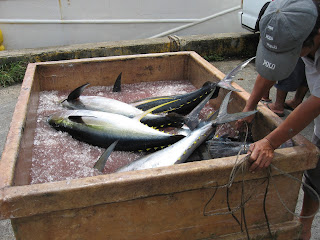It has been a week of filled with several
distressing news stories from around the world concerning shrimp farming,
diseases, and the economic impact for global consumers. That said, this is just more good news
for our company as we move to expand production. Articles continuing to report
news like the following will impact pricing on all sizes of shrimp.
At the European Seafood Expo (April 23-25, 2013), Cui He, vice Executive
President of CAPMA, the Chinese Aquaculture Producers Marketing Association,
said that early mortality syndrome (EMS) was a continuing problem in Southern
China and that China expected to import more shrimp from India, Indonesia and
Ecuador. He indicated that the imports would probably increase world
shrimp prices.
The article below also appeared this week.
April 23, 2013
Europe: 50% of Shrimp Imported from
Southeast Asia Is Short-Weighted
According
to a recent investigation by Belgafood, the
association of Belgian food importers 50 percent of the frozen shrimp imported
into Belgium, France, Germany and the Netherlands from Southeast Asia is
short-weighted because of over-glazing. Out of 240 samples, 120 of them
weighed from 3-28 percent less than what was indicated on the label. “It’s
a very widespread problem,” said Olivier Hottlet, president of Belgafood.
“What we did was to remove the glazing from the product, weigh it and
compare it with its label.” The use of protective glazing for frozen seafood
products is a common practice to prevent dehydration and to deliver a quality product.
The practice of glazing is perfectly legal as long as glazing levels and
product content are labeled correctly on the pack. But, since water is
cheaper than shrimp, some companies are tempted to over-glaze. Customers
wind up paying for ice.
Hottlet
said the study results are known to the European Commission,
and it is “very interested”, but doesn’t intend to take any action. If,
however, individual member states did start investigating, he said, the EC is
“ready to coordinate and broaden...the investigation at the European Union (EU)
level.”
Hottlet
suspects fraud on a similar scale in southern European countries such as Italy,
Greece and Spain, which import most of their shrimp from South American
producers.
(Source: Boletin
Informativo (Cámara Nacional de Acuacultura, Ecuador’s National
Aquaculture Association). Editor, Jorge Tejada (jtejada@cna-ecuador.com). Illegal shrimp
Overglazing “Widespread” in Central Europe. April 16 2013).
For those of us who for the
past decade have been screaming about this and other atrocious practices common throughout the aquaculture industry, this is too funny (Not "ha ha" funny, incredulous funny).
People in the aquaculture
industry think this is news.
Go figure !!!!!
We have been saying this for
years and falsified weights are not limited to "glazed" shrimp.
The liberal use of additives,
preservatives, and other forms of breading and even coconut breading all mask
the weight of the actual shrimp by 10-25%. This has been a common practice in
the industry in many countries for years.
Articles like the two above
are just examples of a myriad of related issues that underscore why we have
spent over a decade developing our production system and our technology.
The growing awareness of these
and other issues plaguing the traditional production of farmed seafood combined
with a growing awareness of the damage we are doing by “over fishing” the
oceans may also explain why suddenly in just the past year there is so much
interest in our technology and production system.
Weight fraud is just the tip
of the iceberg of deeper underlying problems and these are not confined to the
shrimp industry.
In addition to the liberal use
of additives, preservatives, and other forms of breading and even coconut
breading to increase actual weights, other common world wide practices include
the overuse of carcinogenic compounds to retard degradation and mask spoilage,
knowingly using contaminated feeds containing banned substances banned or human
use, the widespread use of poultry offal as feed both as supplemental and very
cheap protein sources and as a primary feed, the use of human waste and the
list goes on.
This does include the enormous
harm traditional aquaculture does to the environment by returning untreated raw
waste water to the oceans and the destruction of mangroves which are essential
to marine nursery systems as well as the “siltation” of pristine coast lines
and reef areas from erosion and run off.
We knew 12 years ago we could
do better.
Two major reasons we are so
confident that our technology will allow us over time to compete profitably in
the production of even smaller sizes than we now grow as a harvest target (such
as U-20's and 21-25 counts) are 1) we believe prices for all sizes of shrimp will continue to
increase due to disease causing supply interruption an 2) the entire world is
getting much more conscious of transparency in the food source chain.
Alarming increases in cancer
in many national populations and increases in food borne diseases from improper
processing and refrigeration have heightened consumer sensitivity and concern
for where there food come from and how is it handled. .
12-15 years ago I was aghast
as I saw these practices everywhere I went around the world, that is why I was
determined to produce marine protein in a better and safer way.
(And frankly nothing has
changed).
We are sitting in a perfect
position to expand production of jumbo white shrimp and over the next 3-5 years
bring several species of fin fish to the market place as a "perfect
storm" of disease, environmental degradation, and an increasingly
concerned global consumer is demanding transparency in the supply chain so they
can be assured what they eat, and what their children eat, is healthy, safe, and
does not destroy the planet.
All of the conditions above and
more, will create a large (global) and profitable demand for our technology and
production. And the environment and the consumer will profit as well.




